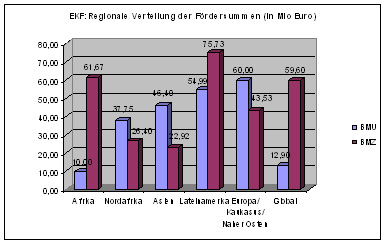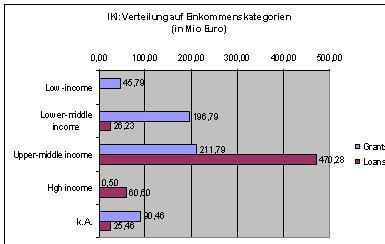German climate finance / Transparency
Interim results of German climate financing – insufficient focus on the poorest countries
A quantitative analysis of project funding by the International Climate Initiative (ICI), the Energy and Climate Fund (EKF) and Germany’s fast-start financing contribution illustrates the funding priorities of the Federal Ministry for the Environment (BMU).
German climate financing uses a range of instruments to fund climate-related measures in developing countries. At present, lists detailing the supported projects and funds are available for the following financing instruments:
- The International Climate Initiative (ICI) of the Federal Ministry for the Environment (BMU)
- Fast-start finance list (FSF): This includes projects funded by the ICI, as well as bilateral and multilateral development cooperation.
- Energy and Climate Fund (EKF): This includes the German Climate and Technology Initiative (DKTI), as well as individual ICI projects.
- Bilateral development cooperation of the Ministry for Economic Cooperation and Development (BMZ): This includes the Initiative for Climate and Environmental Protection (IKLU). In this regard, the lists of the OECD have been available in the past, yet they contain numerous inaccuracies. The BMZ also intends to publish its own list.
The individual lists overlap in some cases. Furthermore, the publication of the BMZ list that would round out the German climate financing picture is still pending. In a first step, the project funding measures by the ICI and EKF, as well as those within the context of Germany’s fast-start financing, were analyzed individually. This was limited to a purely quantitative analysis, however. Statements with regard to the recipients, the degree to which civil society actors are involved, and whether the funded projects are related to poverty alleviation, human rights and gender issues, cannot be made on the basis of the current data. Likewise, most of the data related to climate financing by the BMZ is not available, permitting only limited conclusions to be drawn about its results.
While the analysis thus does not provide an overall picture of German climate financing, important insights can be gained about these three major instruments.
The most vulnerable countries receive little support
 As one of the most severely affected regions, Africa receives far too little funding. Within the ICI, support for sub-Saharan Africa is severely under-represented. This trend is even more significant in the years from 2010 onward. While 13 percent of the total volume is earmarked for Africa, the share decreases to just 6 percent from 2010. At the same time, North Africa will receive even more funding, at 11 percent starting 2010. Furthermore, the financing of projects in Africa falls short of that available to Europe, the Caucasus and the Middle East, even if loans there are not taken into account. In the EKF, sub-Saharan Africa receives only slightly more money than North Africa (14 vs. 13 percent), and less than the Europe/Caucasus/Middle East region (20 percent). In contrast, the BMZ is strongly focused on Africa and has pledged more funds to the region than to Asia, for example. At the BMU, however, Africa is significantly under-represented and receives the least money, €10 million.
As one of the most severely affected regions, Africa receives far too little funding. Within the ICI, support for sub-Saharan Africa is severely under-represented. This trend is even more significant in the years from 2010 onward. While 13 percent of the total volume is earmarked for Africa, the share decreases to just 6 percent from 2010. At the same time, North Africa will receive even more funding, at 11 percent starting 2010. Furthermore, the financing of projects in Africa falls short of that available to Europe, the Caucasus and the Middle East, even if loans there are not taken into account. In the EKF, sub-Saharan Africa receives only slightly more money than North Africa (14 vs. 13 percent), and less than the Europe/Caucasus/Middle East region (20 percent). In contrast, the BMZ is strongly focused on Africa and has pledged more funds to the region than to Asia, for example. At the BMU, however, Africa is significantly under-represented and receives the least money, €10 million.
In the least developed countries (LDC) and small island developing states (SIDS), the contrast is even more pronounced. For the LDCs, support ranges from nine percent of the FSF’s funds to 15 percent for the EKF. The SIDS receive only one percent of EKF and seven percent of ICI funds.
Strong support of newly industrialized countries
Much of the funding is targeted toward the better-off developing and newly industrialized countries, i.e. upper-middle income countries, not only in the form of loans, but also as aid. This group of countries receives significantly more funding than the poorest states.
 With regard to the distribution of ICI financing across the income categories of the World Bank, it is noteworthy that the balance between aid and lending has been adjusted according to individual categories. Thus, no loans are granted to the poorest low-income countries, while the share of loans is significantly higher than that of aid for the upper-middle income countries. However, the absolute figures for the lower-middle and upper-middle income countries significantly exceed those of the poorest countries here as well.
With regard to the distribution of ICI financing across the income categories of the World Bank, it is noteworthy that the balance between aid and lending has been adjusted according to individual categories. Thus, no loans are granted to the poorest low-income countries, while the share of loans is significantly higher than that of aid for the upper-middle income countries. However, the absolute figures for the lower-middle and upper-middle income countries significantly exceed those of the poorest countries here as well.
The two other financing instruments present a similar picture. Only three percent of the resources dispensed within the context of fast-start financing goes to the poorest countries. Also in the case of the EKF, newly industrialized countries as a group receive the largest share of financing. This is especially pronounced in the case of the DKTI, which offers no funding to the poorest countries. Only the BMZ with its EKF funds has a relatively strong focus on the poorest countries, with a share of nearly 20 percent.
More mitigation than adaptation
The breakdown by sector presents a mixed picture. The field of emissions reduction receives significantly more funding from the ICI and FSF. Over the entire duration of the ICI, more than half of the funds are earmarked for measures related to emissions reduction (59 percent), while only 16 percent go toward adaptation. On a positive note, loans are granted only for emissions reduction, but not for adaptation measures. The EKF has a greater focus on adaptation, however, with a share of 40 percent going toward this area. This is due primarily to the BMZ, which pledged just less than 50 percent for adaptation measures. The BMU, by contrast, is only devoting just over 10 percent of its funds to adaptation.
Overall, the analysis shows clearly that the three financial instruments ICI, FSF and EKF are less focused on the poorest countries that stand to suffer the most from climate change. The funds tend to flow into major projects in the field of renewable energy located mainly in newly industrialized countries. In terms of balanced funding, progress can be seen in the promotion of adaptation measures. The analysis thus confirms the focal points of the BMU. To provide a full assessment of German climate financing, information on the BMZ’s measures is urgently needed.
Christine Lottje




